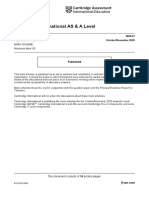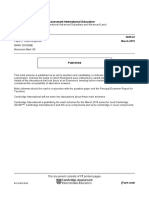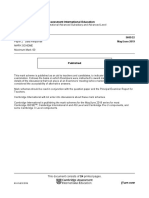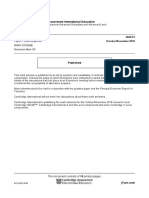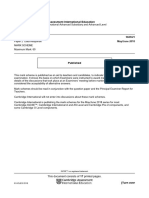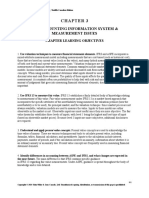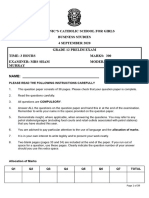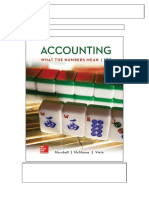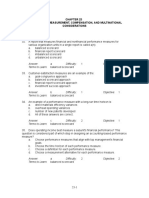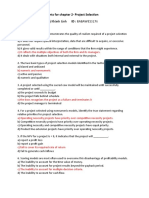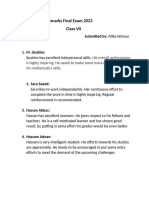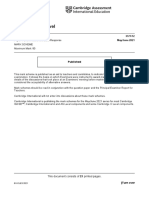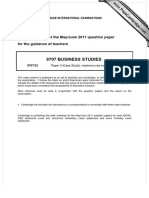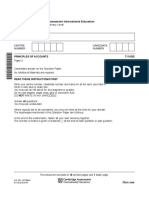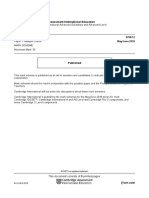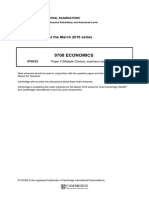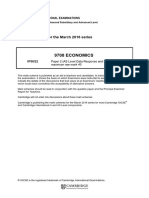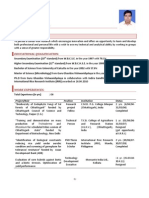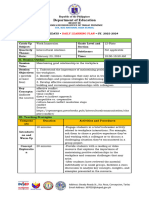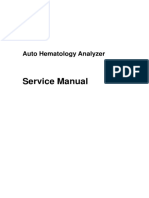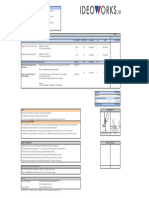9609 m17 Ms 22
9609 m17 Ms 22
Uploaded by
kazamCopyright:
Available Formats
9609 m17 Ms 22
9609 m17 Ms 22
Uploaded by
kazamOriginal Title
Copyright
Available Formats
Share this document
Did you find this document useful?
Is this content inappropriate?
Copyright:
Available Formats
9609 m17 Ms 22
9609 m17 Ms 22
Uploaded by
kazamCopyright:
Available Formats
Cambridge International Examinations
Cambridge International Advanced Subsidiary and Advanced Level
BUSINESS 9609/22
Paper 2 Data Response March 2017
MARK SCHEME
Maximum Mark: 60
Published
This mark scheme is published as an aid to teachers and candidates, to indicate the requirements of the
examination. It shows the basis on which Examiners were instructed to award marks. It does not indicate the
details of the discussions that took place at an Examiners’ meeting before marking began, which would have
considered the acceptability of alternative answers.
Mark schemes should be read in conjunction with the question paper and the Principal Examiner Report for
Teachers.
Cambridge will not enter into discussions about these mark schemes.
Cambridge is publishing the mark schemes for the March 2017 series for most Cambridge IGCSE®,
Cambridge International A and AS Level components and some Cambridge O Level components.
® IGCSE is a registered trademark.
This document consists of 11 printed pages.
© UCLES 2017 [Turn over
9609/22 Cambridge International AS/A Level – Mark Scheme March 2017
PUBLISHED
Question Answer Marks
1(a)(i) Define the term ‘partnership’ (line 1). 2
Knowledge Marks
A correct definition 2
A partial, vague or unfocused definition 1
No creditable content 0
Note: A correct definition must distinguish between a partnership and any
other form of business ownership.
Content
A business formed by two or more people with shared responsibilities
and shared capital investment. Unlimited liability, no continuity. Often
partnerships will have a partnership agreement to separate out
investment and responsibilities.
Exemplar Mark Rationale
A partnership has two or more owners 2 A correct definition
with unlimited liability.
An unincorporated business with more 2 A correct definition
than one owner.
A business formed by two or more 1 This could be
people with shared responsibilities confused with a
and shared capital investment private limited
company
An unincorporated business with 1 This could be
unlimited liability and no continuity. confused with a sole
trader
© UCLES 2017 Page 2 of 11
9609/22 Cambridge International AS/A Level – Mark Scheme March 2017
PUBLISHED
Question Answer Marks
1(a)(ii) Briefly explain the term ‘crowd funding’ (line 16). 3
Award one mark for each point of explanation:
C Example of some other way of showing good 1 mark
understanding, i.e. rewards, returns etc.
B Each contributing a (relatively small) amount or from 1 mark
each individual
A Large number of people 1 mark
Note: No credit for stating that crowd funding is a source of finance, as
this is stated in the data.
Content
Crowd funding is the practice of funding a project or venture by raising
monetary contributions from a large number of people, typically via the
internet. Typically made up of the business who is looking for funding, the
people who may wish to fund the business and an intermediary
organisation/agent who link the two together.
There are different types of crowd funding, such as debt crowd funding
and equity crowd funding where the rewards may be advance products
or services, visits to the factor, interest or shares/equity in the business.
1(b)(i) Refer to Table 1. Calculate the break-even level of production with 3
CAM.
Mark Rationale
3 marks Correct calculation of break-even level of production with
CAM (with or without working)
2 marks Attempt with correct use of figures
1 mark Correct formula
0 marks No creditable content
Content
FC
Formula: or TR=TC (1)
Contribution (1)
Contribution = $2.50 – $1.00 = $1.50 (1)
15 000
= 10 000 (1)
1.50
Answer = 10 000 (3)
Correct answer with no working should be awarded 3 marks.
OFR
© UCLES 2017 Page 3 of 11
9609/22 Cambridge International AS/A Level – Mark Scheme March 2017
PUBLISHED
Question Answer Marks
1(b)(ii) Explain one benefit to GI of using break-even analysis 3
Level Knowledge and Application Marks
2b Explanation of a benefit of using break-even 3
(APP analysis in context
+APP)
2a Identification of a benefit of using break-even 2
(APP) analysis in context
1 (K) Shows understanding of the use of break-even 1
analysis
0 No creditable content 0
Correct use of an incorrect answer to 1(b)(i) should be fully rewarded
(own figure rule – OFR)
No credit for knowledge of BE or formula – already awarded in previous
question.
Content
Answers may include:
• decisions over how many to make/sell
• to plan production
• to monitor costs
• to model pricing options
• to target/forecast a profit level
• to target/forecast a margin of safety.
Context may include:
• BE is higher with CAM
• probably due to extra machinery
• however output is significantly higher
• as is the profit margin
• batch production
• expansion throughout country
• quality ice cream – not about quantity.
© UCLES 2017 Page 4 of 11
9609/22 Cambridge International AS/A Level – Mark Scheme March 2017
PUBLISHED
Question Answer Marks
1(c) Analyse two possible disadvantages to GI of introducing CAM to 8
produce ice cream.
Knowledge
and Analysis
Level Marks Marks
Application (4 marks)
(4 marks)
Good analysis of two (or
more) disadvantages of
4 4
Shows introducing/using CAM in
understanding context
2
of CAM in Good analysis of one
context disadvantage of
3 3
introducing/using CAM in
context
Limited analysis of two (or
more) disadvantages of 2
Shows introducing/using CAM
1 knowledge of 1–2
CAM Limited analysis of one
disadvantage of 1
introducing/using CAM
0 No creditable content
A non-contextual answer can only be awarded a maximum of 2 + 2 = 4
Content
Answers could include:
• Possible loss of quality in the production of the ice cream – could
lead to poor customer satisfaction (GI makes and sells high quality
ice cream).
• Possible loss of perceived quality as the business loses it's
'handmade' badge.
• Cost of introducing the technology ($10 000 extra FC costs per
month).
• Damage to the relationship with the five skilled workers.
• Loss of skills (GI employs five skilled workers).
• Reliability of the machinery (GI do not have the money to repair it –
as seen in their need to raise $50 000 form venture capitalists).
• Need for training/retraining as the employees are already trained in
handmaking ice-cream.
ARA
© UCLES 2017 Page 5 of 11
9609/22 Cambridge International AS/A Level – Mark Scheme March 2017
PUBLISHED
Question Answer Marks
1(d) Recommend which of the two venture capital offers Tom and Amy 11
should accept. Justify your answer.
Knowledge and Analysis and Evaluation
Marks Marks
Application (4 marks) (7 marks)
A justified
recommendation, for Tom
and Amy, which venture
7
capital offer they should
accept based on a
balanced argument.
A recommendation, for
Tom and Amy, which
venture capital offer they 6
should accept based on a
balanced argument.
A balanced argument
based on one or both
5
venture capital offers with
evaluative comments
Shows understanding 3–4 Two sided argument(s)
of one or both venture based on one or both 4
capital offers venture capital offers
One sided argument
based on one venture 3
capital offer
Shows knowledge of Limited analysis of venture
1–2 1–2
venture capital capital
Justification can come from looking at the advantages and/or
disadvantages of BOTH offers, or from the advantages and
disadvantages of the recommended offer.
Answers could include:
Offer 1
• Loss of control – 51% equity given away – are Tom and Amy willing
to give up so much?
• Ease of distribution – should allow easier national expansion
• Marketing knowledge and expertise – again should allow easier
expansion
Offer 2
• Lower equity stake required – Tom and Amy would keep overall
control of the business
• Use of CAM will reduce costs of expansion – may further lower BE
point and increase profit margin
• Experience of Rebecca in project management and ops man – very
important for expansion.
ARA
© UCLES 2017 Page 6 of 11
9609/22 Cambridge International AS/A Level – Mark Scheme March 2017
PUBLISHED
Question Answer Marks
2(a)(i) Define the term ‘profit margin’ (line 5). 2
Knowledge Marks
A correct definition 2
A partial, vague or unfocused definition 1
No creditable content 0
Content
Measure of the profitability (not profit) of a business. Calculated by
finding the profit for the year as a percentage of revenue. Proportion of
revenue that is profit for the year.
2(a)(ii) Briefly explain the term ‘above the line promotion’ (line 12). 3
Award one mark for each point of explanation:
C Example or some other way of showing good 1 mark
understanding
B Through a media 1 mark
A Communication/advertising/creating awareness to 1 mark
consumers/customers
Content
Above The Line promotion is the use of media to promote a business and
reach out to the target consumers.
These include conventional media, television and radio advertising, print
as well as internet. This is communication that is targeted to a wider
spread of audience, and is not specific to individual consumers.
© UCLES 2017 Page 7 of 11
9609/22 Cambridge International AS/A Level – Mark Scheme March 2017
PUBLISHED
Question Answer Marks
2(b)(i) Refer to Table 2. Calculate the price elasticity of demand for a 3
change in price from $8 to $6 per hour.
Mark Rationale
3 marks Correct answer with or without working
2 marks Attempt with correct use of figures
1 mark Formula
0 marks No creditable content
Formula:
% Change in QD
% Change in P
% change in QD 5/50*100 = 10%
% change in P 2/8*100 = 25%
Answer = (–)0.4
Note: Minus sign not required.
Common incorrect answers
Answer Mark Rationale
25% 2 Formula wrong way round
= 2.5
10%
10% 2 Obvious (implied) knowledge of
25% formula but no attempt to calculate
answer (or the attempt is wrong)
10% 2 As above
= Inelastic
25%
5 1 Candidate missed the % out of the
= 2.5 formula (twice)
2
10% and/or 25% 1 No formula or attempt to put %
changes in a formula
Inelastic 1 Some understanding but no
calculation
Change in QD 0 Formula is wrong – no %
Change in P
2.5 0 No working
© UCLES 2017 Page 8 of 11
9609/22 Cambridge International AS/A Level – Mark Scheme March 2017
PUBLISHED
Question Answer Marks
2(b)(ii) Explain one way in which CT could make use of price elasticity of 4
demand calculations.
Level Knowledge and Application Marks
2b Explanation of a way PED could be used in 3
(APPAPP) context
2a (APP) Identification of a way PED could be used in 2
context
1a (K) Shows understanding of the use of PED 1
0 No creditable content 0
Correct use of an incorrect answer to 1(b)(i) should be fully rewarded
(own figure rule –OFR).
No credit for knowledge of PED or formula – already awarded in previous
question.
Content
Answers could include:
• Can see that cleaning services are price inelastic (OFR).
• CT should not reduce their price – they should increase their price
back to the original level (or increase it further).
• Price is obviously not the most important factor when customers
purchase cleaning services.
• PED can be used to calculate revenue based on price changes.
© UCLES 2017 Page 9 of 11
9609/22 Cambridge International AS/A Level – Mark Scheme March 2017
PUBLISHED
Question Answer Marks
2(c) Analyse one advantage and one disadvantage to CT of being an 8
employee-owned business.
Knowledge
and
Level Marks Analysis (4 marks) Marks
Application
(4 marks)
Good analysis of one (or
more) advantage(s) AND
one (or more)
4
Shows disadvantage(s) of being
understanding an employee-owned
of employee business in context
2 3–4
owned Good analysis of one (or
businesses in more) advantage(s) OR
context one (or more)
3
disadvantage(s) of being
an employee-owned
business in context
Limited analysis of one (or
more) advantage(s) AND
one (or more)
2
disadvantage(s) of being
Shows an employee-owned
knowledge of business
1 employee 1–2
owned Limited analysis of one (or
businesses more) advantage(s) OR
one (or more)
1
disadvantage(s) of being
an employee-owned
business
Answers could include:
Context:
• equal ownership
• different skills in cleaning
• each owner may have different personal contacts – cleaning homes
• each owner may have different business contacts to expand into the
industrial market.
Advantages:
• working together to solve problems
• economies of scale
• motivation from being owners/sharing profits.
Disadvantages:
• disagreements – who is in control?
• if there is a manager do they have authority
• do the workers have the management skills?
• could be a lack of capital investment
• could lead to slow decision making.
© UCLES 2017 Page 10 of 11
9609/22 Cambridge International AS/A Level – Mark Scheme March 2017
PUBLISHED
Question Answer Marks
2(d) Discuss how CT's marketing mix might need to change to target 11
customers in the industrial market.
Knowledge and Marks Analysis and Evaluation Marks
Application (4 marks) (7 marks)
Justified evaluation that
follows on from a
balanced argument of 7
change(s) to the marketing
mix in context
Evaluation that follows on
from a balanced
argument of change(s) to 6
the marketing mix in
context
A balanced argument
based on change(s) to the 5
marketing mix in context
Shows understanding Argument based on
of the marketing mix in 3–4 change(s) to the marketing 3–4
context mix in context
Limited analysis of how
Shows knowledge of the marketing mix might
1–2 1–2
the marketing mix change/be changed
No creditable content
Content:
Answers could include:
• Product – the businesses will expect evening/night-time cleaning –
will CT have employees who are willing to do this? Will they expect
higher remuneration for anti-social hours? However the essence the
service on offer is the same.
• Price – need to find out how sensitive the industrial market is to
price? Likely to be more price elastic due to being a cost of business.
Therefore CT may find themselves in a more competitive market and
need to charge lower prices/have lower margin.
• May need to move towards below the line promotion – above the line
likely to be expensive to target industrial market (except trade
magazines). May need to employ sales people to target businesses
directly.
• Industrial customers are unlikely to come to them (i.e. phone or book
on internet) so CT will need to be more proactive in finding
customers.
© UCLES 2017 Page 11 of 11
You might also like
- (MS01) As Business v2Document16 pages(MS01) As Business v2shalynngatereNo ratings yet
- MBA 7001 Accounting For Decision Makers AssignmentDocument8 pagesMBA 7001 Accounting For Decision Makers AssignmentSupun25% (4)
- Chapter 08Document48 pagesChapter 08925ff2a357No ratings yet
- GEOGRAPHY IGCSE Riassunti PP 4-46, 52-151Document28 pagesGEOGRAPHY IGCSE Riassunti PP 4-46, 52-151tommaso100% (1)
- Oracle Fusion Tools PDFDocument31 pagesOracle Fusion Tools PDFSAlah MOhammed0% (1)
- Cambridge International Examinations: Business 9609/22 March 2017Document11 pagesCambridge International Examinations: Business 9609/22 March 2017RuslanNo ratings yet
- Cambridge International AS & A Level: Business 9609/23 May/June 2020Document11 pagesCambridge International AS & A Level: Business 9609/23 May/June 2020Rinnah TeklayNo ratings yet
- Cambridge International AS & A Level: Business 9609/23 May/June 2020Document11 pagesCambridge International AS & A Level: Business 9609/23 May/June 2020VinayakNo ratings yet
- Cambridge International AS & A Level: Business 9609/23 October/November 2020Document16 pagesCambridge International AS & A Level: Business 9609/23 October/November 2020Kwadwo AsareNo ratings yet
- Cambridge Assessment International Education: Business 9609/23 May/June 2018Document11 pagesCambridge Assessment International Education: Business 9609/23 May/June 2018LightNo ratings yet
- Case A Marking RubricDocument4 pagesCase A Marking RubricKrrishna Rajesh TOKARAWATNo ratings yet
- Maximum Mark: 60: Cambridge International Advanced Subsidiary and Advanced LevelDocument8 pagesMaximum Mark: 60: Cambridge International Advanced Subsidiary and Advanced Leveltafadzwa tandawaNo ratings yet
- Cambridge Assessment International Education: Business 9609/22 March 2019Document17 pagesCambridge Assessment International Education: Business 9609/22 March 2019Reddy GirinathNo ratings yet
- Cambridge International AS & A Level: Business 9609/22 October/November 2020Document20 pagesCambridge International AS & A Level: Business 9609/22 October/November 2020Kwadwo AsareNo ratings yet
- Cambridge International Examinations: Business 9609/13 May/June 2017Document10 pagesCambridge International Examinations: Business 9609/13 May/June 2017Nisar AhmedNo ratings yet
- 9609 s19 Ms 22Document24 pages9609 s19 Ms 22Wajiha NadeemNo ratings yet
- Cambridge Assessment International Education: Business 9609/23 October/November 2018Document16 pagesCambridge Assessment International Education: Business 9609/23 October/November 2018Simbaraishe JikiseraNo ratings yet
- Cambridge Assessment International Education: Business 9609/12 October/November 2017Document10 pagesCambridge Assessment International Education: Business 9609/12 October/November 2017lushandalpadadoNo ratings yet
- Cambridge International Examinations: Business 9609/22 May/June 2017Document20 pagesCambridge International Examinations: Business 9609/22 May/June 2017Roger FedererNo ratings yet
- Cambridge Assessment International Education: Business 9609/21 May/June 2019Document17 pagesCambridge Assessment International Education: Business 9609/21 May/June 2019tafadzwa tandawaNo ratings yet
- Sample Mark Scheme Level 5 Effective Financial Management: Section A - 20 MarksDocument12 pagesSample Mark Scheme Level 5 Effective Financial Management: Section A - 20 MarksTheocryte SergeotNo ratings yet
- Published Answer Marks Identify One Element of The Triple Bottom Line. 1Document14 pagesPublished Answer Marks Identify One Element of The Triple Bottom Line. 1Abirami BrabuNo ratings yet
- Cambridge International AS & A Level: Business 9609/22 March 2020Document15 pagesCambridge International AS & A Level: Business 9609/22 March 2020Ayush OjhaNo ratings yet
- Cambridge Assessment International Education: Business 9609/21 May/June 2018Document17 pagesCambridge Assessment International Education: Business 9609/21 May/June 2018badu.augustinekwameNo ratings yet
- Cambridge Assessment International Education: Business 9609/11 October/November 2017Document10 pagesCambridge Assessment International Education: Business 9609/11 October/November 2017RuslanNo ratings yet
- CH 03Document17 pagesCH 03时家欣No ratings yet
- Cambridge Assessment International Education: Business 9609/21 October/November 2018Document16 pagesCambridge Assessment International Education: Business 9609/21 October/November 2018Low JeNo ratings yet
- Business Jun 2019 Paper 2 MSsDocument17 pagesBusiness Jun 2019 Paper 2 MSsrolax68107No ratings yet
- Grade 12 Business Studies Prelim 2020Document39 pagesGrade 12 Business Studies Prelim 2020Rolandi ViljoenNo ratings yet
- Cambridge International Examinations: Business 9609/12 May/June 2017Document11 pagesCambridge International Examinations: Business 9609/12 May/June 2017AbdulBasitBilalSheikhNo ratings yet
- Cambridge International AS & A Level: Business 9609/12 October/November 2020Document15 pagesCambridge International AS & A Level: Business 9609/12 October/November 2020Jawad NadeemNo ratings yet
- Cambridge Assessment International Education: Business 9609/11 October/November 2019Document15 pagesCambridge Assessment International Education: Business 9609/11 October/November 2019skaugfdgvwafNo ratings yet
- 9609 MW ScriptAC P1 MSDocument14 pages9609 MW ScriptAC P1 MS章琳雯No ratings yet
- Cambridge O Level: Business Studies 7115/11 May/June 2020Document11 pagesCambridge O Level: Business Studies 7115/11 May/June 2020Fred SaneNo ratings yet
- Fin501: Financial Management MBA BRAC University Final Examination Paper: 3rd of January 2021 Total Time: Three (3) Hours Total: 60 MarksDocument16 pagesFin501: Financial Management MBA BRAC University Final Examination Paper: 3rd of January 2021 Total Time: Three (3) Hours Total: 60 MarksyousufNo ratings yet
- Cambridge IGCSE™: Business Studies 0450/11 May/June 2020Document10 pagesCambridge IGCSE™: Business Studies 0450/11 May/June 2020Daniel NAMNo ratings yet
- Universiti Teknologi Mara Common Test 1: Confidential AC/AUG 2016/MAF253Document6 pagesUniversiti Teknologi Mara Common Test 1: Confidential AC/AUG 2016/MAF253Bonna Della TianamNo ratings yet
- Cambridge International AS & A Level: BUSINESS 9609/22Document16 pagesCambridge International AS & A Level: BUSINESS 9609/22benteachesviNo ratings yet
- Cambridge International AS & A Level: Economics 9708/41 October/November 2020Document10 pagesCambridge International AS & A Level: Economics 9708/41 October/November 2020fahmed7574No ratings yet
- Mark Scheme (Results) Summer 2019Document18 pagesMark Scheme (Results) Summer 2019Hadeel DossaNo ratings yet
- Cambridge International AS & A Level: Business 9609/22 March 2021Document16 pagesCambridge International AS & A Level: Business 9609/22 March 2021LisaNo ratings yet
- Mark Scheme 3UBE Business Essentials June 2019: General Marking GuidanceDocument9 pagesMark Scheme 3UBE Business Essentials June 2019: General Marking Guidance7777gracieNo ratings yet
- Financial Reporting II ACC 402/602, Section 1001-1002 Practice Exam 1Document12 pagesFinancial Reporting II ACC 402/602, Section 1001-1002 Practice Exam 1Joel Christian MascariñaNo ratings yet
- SME IIT Jodhpur ExamDocument15 pagesSME IIT Jodhpur ExamJatin yadavNo ratings yet
- WJEC Economics AS Unit 2 MS S19Document17 pagesWJEC Economics AS Unit 2 MS S19angeleschang99No ratings yet
- Cambridge International AS & A Level: Business 9609/11 May/June 2020Document14 pagesCambridge International AS & A Level: Business 9609/11 May/June 2020VinayakNo ratings yet
- 9707 s13 Ms 21Document5 pages9707 s13 Ms 21lexyaNo ratings yet
- 9707 Business Studies: MARK SCHEME For The October/November 2013 SeriesDocument7 pages9707 Business Studies: MARK SCHEME For The October/November 2013 SeriesAHMADNo ratings yet
- Business Studies 2022Document32 pagesBusiness Studies 2022ntwenhlet706No ratings yet
- Senior School Certificate Examination March - 2023 Marking Scheme - Business Studies 66/1/1, 66/1/2, 66/1/3Document26 pagesSenior School Certificate Examination March - 2023 Marking Scheme - Business Studies 66/1/1, 66/1/2, 66/1/3bhaiyarakeshNo ratings yet
- Cambridge Assessment International Education: Business 9609/11 October/November 2018Document14 pagesCambridge Assessment International Education: Business 9609/11 October/November 2018Low JeNo ratings yet
- Test Bank For Accounting 12th Us Edition by MarshallDocument34 pagesTest Bank For Accounting 12th Us Edition by Marshallte.stbankyNo ratings yet
- Cambridge International Examinations Cambridge International Advanced Subsidiary and Advanced LevelDocument9 pagesCambridge International Examinations Cambridge International Advanced Subsidiary and Advanced LevelNathania PriscillaNo ratings yet
- Cambridge IGCSE: Business Studies For Examination From 2020Document10 pagesCambridge IGCSE: Business Studies For Examination From 2020frederickNo ratings yet
- 9706 m19 Ms 32Document22 pages9706 m19 Ms 32Ryan Xavier M. BiscochoNo ratings yet
- Cambridge IGCSE™: Business Studies 0450/13 October/November 2020Document20 pagesCambridge IGCSE™: Business Studies 0450/13 October/November 2020ESHMEET KAUR MALHOTRANo ratings yet
- Answer Mock PPR 2 Econs PDFDocument14 pagesAnswer Mock PPR 2 Econs PDFHamiz AizuddinNo ratings yet
- C2A April 2012 Questions PDFDocument6 pagesC2A April 2012 Questions PDFJeff GundyNo ratings yet
- Accountant in Business Mock Exam 2: (Duration: 3 Hours)Document14 pagesAccountant in Business Mock Exam 2: (Duration: 3 Hours)Man Ish K DasNo ratings yet
- Ch23-PERFORMANCE MEASUREMENT, COMPENSATION, AND MULTINATIONAL CONSIDERATIONSDocument17 pagesCh23-PERFORMANCE MEASUREMENT, COMPENSATION, AND MULTINATIONAL CONSIDERATIONSRommel CruzNo ratings yet
- Assignments For Chapter 2 Project Selection - BABAWE13276Document4 pagesAssignments For Chapter 2 Project Selection - BABAWE13276Thi Khanh Linh PhamNo ratings yet
- 0132 Awais BilalDocument2 pages0132 Awais BilalkazamNo ratings yet
- Remarks For 7 Final TermDocument3 pagesRemarks For 7 Final TermkazamNo ratings yet
- Kazam Raza CV 3Document1 pageKazam Raza CV 3kazamNo ratings yet
- 9708 w19 Ms 42 PDFDocument13 pages9708 w19 Ms 42 PDFkazamNo ratings yet
- Cambridge O Level: Business Studies 3177/12 May/June 2021Document21 pagesCambridge O Level: Business Studies 3177/12 May/June 2021kazamNo ratings yet
- 7110 s19 Ms 21 PDFDocument15 pages7110 s19 Ms 21 PDFkazam100% (1)
- Gmail - FCC Admission Test Slip Fall 2021Document1 pageGmail - FCC Admission Test Slip Fall 2021kazamNo ratings yet
- 9708 w19 QP 42 PDFDocument4 pages9708 w19 QP 42 PDFkazamNo ratings yet
- 9707 s09 Ms 3 PDFDocument6 pages9707 s09 Ms 3 PDFkazamNo ratings yet
- After Sales Service QDocument2 pagesAfter Sales Service QkazamNo ratings yet
- Financial Analysis (Chapter 3)Document18 pagesFinancial Analysis (Chapter 3)kazamNo ratings yet
- 9707 s11 Ms 32 PDFDocument10 pages9707 s11 Ms 32 PDFkazamNo ratings yet
- Cambridge Ordinary Level: Cambridge Assessment International EducationDocument20 pagesCambridge Ordinary Level: Cambridge Assessment International EducationkazamNo ratings yet
- Eco Ms MJ 2018 p1Document3 pagesEco Ms MJ 2018 p1Iqra AhmedNo ratings yet
- Cambridge Assessment International Education: Economics 9708/41 October/November 2018Document10 pagesCambridge Assessment International Education: Economics 9708/41 October/November 2018kazamNo ratings yet
- Grade Thresholds - March 2019: Cambridge International AS & A Level Economics (9708)Document1 pageGrade Thresholds - March 2019: Cambridge International AS & A Level Economics (9708)kazamNo ratings yet
- 9708 m16 Ms 32 PDFDocument2 pages9708 m16 Ms 32 PDFkazamNo ratings yet
- 9708 Economics: MARK SCHEME For The March 2016 SeriesDocument6 pages9708 Economics: MARK SCHEME For The March 2016 SerieskazamNo ratings yet
- Neural Control and CoordinationDocument8 pagesNeural Control and CoordinationAman Singh RaoNo ratings yet
- 2500 Automatic Tank GaugeDocument42 pages2500 Automatic Tank GaugeLicenciado Cantinas100% (1)
- Dr. Kuntal Das - ResumeDocument5 pagesDr. Kuntal Das - ResumeKuntal DasNo ratings yet
- Task 2Document10 pagesTask 2api-242257516No ratings yet
- Arm Cortex-R Comparison TableDocument2 pagesArm Cortex-R Comparison TablekalapepeNo ratings yet
- CSS Hand Tools MorphDocument27 pagesCSS Hand Tools MorphJef VegaNo ratings yet
- Catch Up Fridays DLP Template SY 2023 2024Document2 pagesCatch Up Fridays DLP Template SY 2023 2024Nimrod CabreraNo ratings yet
- Organic Farming BrochureDocument16 pagesOrganic Farming BrochureDeb PradhanNo ratings yet
- Session 19: A Detour Into Asset Based Valuation: Aswath DamodaranDocument14 pagesSession 19: A Detour Into Asset Based Valuation: Aswath DamodaranYounes HamouchiNo ratings yet
- Section of Solids (Engineering Drawing)Document14 pagesSection of Solids (Engineering Drawing)Siddhant SidNo ratings yet
- BINHS Chapter 1 Research Format 2022 2023Document27 pagesBINHS Chapter 1 Research Format 2022 2023Sahara HaintoNo ratings yet
- United States Bankruptcy Court Southern District of New YorkDocument41 pagesUnited States Bankruptcy Court Southern District of New YorkChapter 11 DocketsNo ratings yet
- Spending & Saving Habits of Youth in The City of AurangabadDocument9 pagesSpending & Saving Habits of Youth in The City of AurangabadAisyah HannaniNo ratings yet
- PHP Data TypesDocument5 pagesPHP Data Types159No ratings yet
- Science 6 Living Things and Their Environment Earth and Space As Reviewed by SME 1Document36 pagesScience 6 Living Things and Their Environment Earth and Space As Reviewed by SME 1Elma Ortega CamionNo ratings yet
- Peet Greenvale Syndicate FINAL 180113Document21 pagesPeet Greenvale Syndicate FINAL 180113markos_8333No ratings yet
- Cerita Dongeng Dalam Bahasa InggrisDocument1 pageCerita Dongeng Dalam Bahasa InggrisSENINA PROJECTNo ratings yet
- Historical Antecedents in The Course of Science and TechnologyDocument21 pagesHistorical Antecedents in The Course of Science and TechnologykylNo ratings yet
- Shafer Rv-Series Brochure PDFDocument8 pagesShafer Rv-Series Brochure PDFSeaman NoNo ratings yet
- Koegel Bimbela Schreibman 1996 Collateral Effectsof Parent TrainingDocument14 pagesKoegel Bimbela Schreibman 1996 Collateral Effectsof Parent Trainingdaniela alfaro gauneNo ratings yet
- Mindray BC 3600 Service ManualDocument242 pagesMindray BC 3600 Service ManualAstley TattaoNo ratings yet
- CS56B Specalog HRCDocument2 pagesCS56B Specalog HRCquirionjasonNo ratings yet
- Valve List Compress Air SystemDocument3 pagesValve List Compress Air SystemFiauni VoNo ratings yet
- Seminar ReportDocument17 pagesSeminar ReportThushar DNo ratings yet
- Chubb Life 2023 - Media Plan - MP - Aug-Dec.V2Document1 pageChubb Life 2023 - Media Plan - MP - Aug-Dec.V2widiasusi94No ratings yet
- Den TonicDocument23 pagesDen Tonickzm3No ratings yet
- SHEIN and SPARC Group Join in A Strategic Partnership - SHEIN GroupDocument3 pagesSHEIN and SPARC Group Join in A Strategic Partnership - SHEIN GroupDinheirama.comNo ratings yet
- France Educational SystemDocument20 pagesFrance Educational SystemMissaerence Jane GeraldeNo ratings yet









